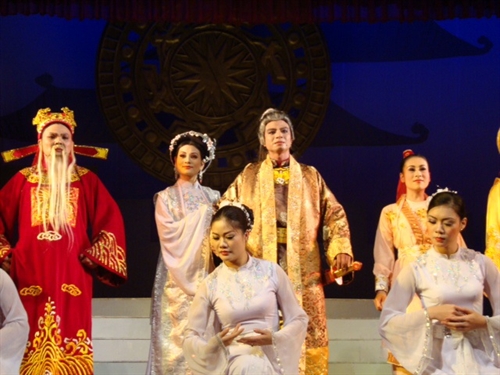 Life & Style
Life & Style

Dozens of young and veteran actors performed recently at the Artists Pagoda, also known as the Nhật Quang Tự (Sunlight Pagoda), in HCM City’s Gò Vấp District, to lure fans back to traditional theatre.
 |
| Art heritage: Many young and veteran artists in cải lương (reformed opera) and tuồng (classical drama) have performed at temples and pagodas in HCM City and southern provinces to lure fans back to the traditional theatre. - Photo Thanh Hiệp |
By Thu Anh
HCM CITY – Dozens of young and veteran actors performed recently at the Artists Pagoda, also known as the Nhật Quang Tự (Sunlight Pagoda), in HCM City’s Gò Vấp District, to lure fans back to traditional theatre.
The singers staged extracts from cải lương (reformed opera) and tuồng (classical drama) plays featuring historical events and national heroes, such as Trưng Nữ Vương (Queen Trưng), Bạch Đằng Giang (Bạch Đằng River) and Trống Đồng Ngọc Lũ (Ngọc Lũ Bronze Drum).
The plays were staged to raise funds for the pagoda, the only one of its kind in the city that contains a cemetery for death traditional music performers.
"The Nhật Quang Tự is owned by the late People’s Artist Phùng Há, an iconic figure in cải lương theatre. It is the setting for cải lương and hát bội performances, starring younger singers from different theatres and art troupes in the region,” said Thoại Mỹ, one of many Há’s students.
“We found it refreshing to perform for fans here. We tried to offer free performances monthly," she added.
Mỹ and her colleagues staged the performances at the pagoda early this month to celebrate the 6th anniversary of the death of Há, their teacher. The show attracted hundreds of residents and visitors.
According to Mỹ, performances at temples were popular in southern provinces over previous decades. Artists performed outdoors for local people after a day of hard work.
“The activity is being lost because of modern life. We are working to recover the art to encourage young people to learn about the music,” Mỹ said.
Each show at the pagoda features at least 30 artists and musicians.
The pagoda’s owner Há began her career in 1923. She worked for the Tái Đồng Ban, a leading cải lương troupe in Mỹ Tho Province, the cradle of cải lương art.
In the 1950s, Há, known as Miss Bảy, was at the peak of her artistry and fame. She performed in many serious plays such as Đời Cô Lựu (Mis Lựu’s Life) and Tô Ánh Nguyệt, which are recognised as part of the cải lương canon.
In those plays, Há depicted the tragedy of Vietnamese women under feudalism, focusing on beautiful and virtuous girls who suffered from the oppression of village officials and landowners.
Há spent her savings to build Nhật Quang Tự in 1958, aiming to run it as a charity cemetery for traditional artists. The pagoda now serves as a place of rest for more than 1,000 traditional performers, who were often stars on the stage but were poor and unsupported in old age.
Working with the pagoda’s managing board, artists have offered free performances and collected donations from individuals and organisations to run the pagoda. Last year, their shows raised more than VNĐ3 billion (US$180,000) for charity.
"The country’s spirit is based on traditional arts. Our children can’t grow up without love and respect for the arts,” said Nguyễn Kiến Phước, a member of the managing board of Nhơn Nghĩa Temple in Bến Tre Province.
“We often invite hát bội and cải lương troupes to perform in traditional ceremonies and festivals launched by our temple, which I think is the best way to help residents and visitors learn about the Vietnamese folk art,” he said.
The HCM City Hát Bội Theatre, one of the region’s most prestigious theatres, has educated and sent young artists to perform at ceremonies and festivals launched by temples in the city and southern provinces such as Bà Rịa-Vũng Tàu, Vĩnh Long, Cần Thơ, Tiền Giang and Sóc Trăng.
To meet audience demand, next month, a series of cải lương and tuồng plays will be staged at several temples, including Lăng Ông Bà Chiều Temple in HCM City’s Bình Thạnh District, Bình Thủy Temple in Cần Thơ Province, and Thuận Hóa Temple in Sóc Trăng Province. — VNS




